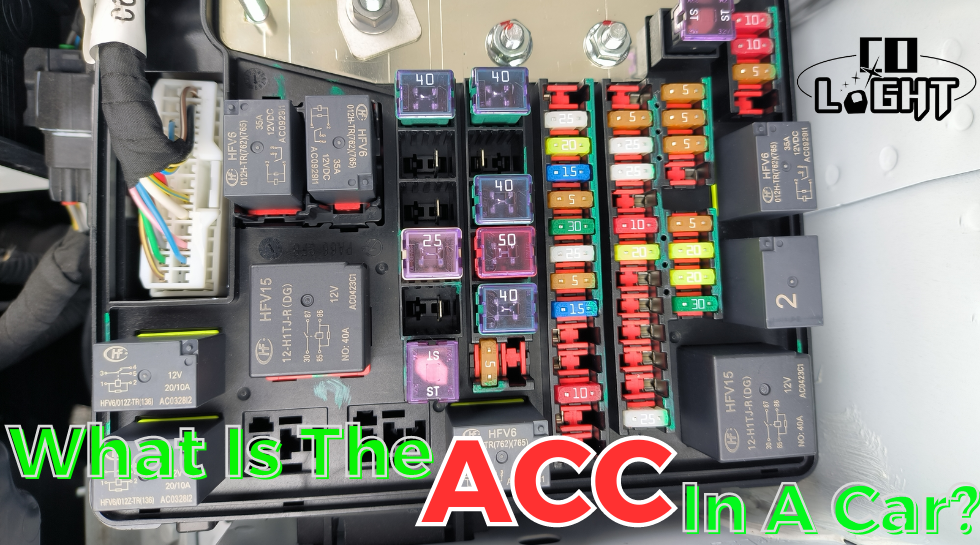In modern automotive electrical systems, there is a mysterious yet crucial wire known as the "ACC wire," also referred to as the "Accessory wire." While it may not be as conspicuous as the engine, brakes, or suspension system, the ACC wire plays an indispensable role in providing convenience and comfort to our driving experience. Serving as an eye-catching detail, the ACC wire supplies power to vehicle accessories such as the radio, navigation system, and car chargers, enabling us to enjoy our journeys with more pleasure and convenience.
This blog aims to unravel the mysteries of the automotive ACC wire, delving into its functions, essential considerations and related Q&A. We will take you on a journey to understand this seemingly ordinary yet indispensable electrical component. Through this article, we hope to enhance your comprehension and utilization of the ACC wire, adding a touch of convenience and joy to your driving life. Let's embark on this quest together to unveil the enigmatic essence of the ACC wire!
What Is ACC?
ACC wire is an essential circuit in the automotive electrical system, with its full name being "Accessory wire." It is a power supply line designed to provide electricity to the vehicle's accessory devices. When the vehicle's ignition switch is turned to the "ACC" or "ON" position, the ACC wire activates the vehicle's accessory devices, such as the radio, navigation system, and car chargers, allowing them to continue functioning or stay charged even after the vehicle is turned off. Additionally, during vehicle operation, the ACC wire ensures a stable power supply to these accessory devices.
With the ACC wire in action, car owners can enjoy better in-car entertainment and a convenient navigation experience while having the convenience of charging their devices, such as mobile phones. As a result, the ACC wire plays a significant role in enhancing driving comfort and convenience, making it an indispensable part of the modern automotive electrical system.
The Role Of Acc Wires
The function of the car's ACC line (Accessory line) is to supply power to the accessories on the vehicle without starting the engine. When you turn the car key to the "ACC" (Accessory) position, the ACC line is activated, providing power to the vehicle's accessory devices. This allows you to use certain electrical equipment, such as the radio, sound system, GPS navigation, and car phone charger, while the vehicle is in the OFF state.
The importance of the ACC line in the vehicle's electrical system lies in its convenience, as it allows drivers and passengers to use certain functions without having to start the entire vehicle when the engine is off. This helps save energy and extend the lifespan of the vehicle's battery while providing a certain level of comfort and entertainment inside the car.
Typically, a car's key has several positions: OFF, ACC (Accessory), ON, and START. In the ACC position, the vehicle's electrical system is activated, but the engine is not started. In the ON and START positions, in addition to activating the electrical system, the engine is started, allowing the vehicle to be driven.
In summary, the function of the car's ACC line is to provide power to accessory devices while the vehicle is in the OFF state, allowing you to use certain electrical equipment without starting the engine.
How To Find Your Vehicle's ACC Wire

Location:
- Near the car keyhole: In many car models, there is usually an interface for the ACC (Accessory) wire around the car key insertion hole.
- At the ignition switch of the car: The ACC wire is typically associated with the connection of the vehicle's ignition switch.
- Center console: The ACC wire may be hidden behind or underneath the center console, supplying power to accessory devices on the console.
- Radio hole: If you plan to install a new radio or audio system, the ACC wire may be connected to the power interface of the new device.
- Car accessory socket: Some vehicles may provide additional sockets for connecting accessory devices to the ACC power.
- Refer to the Vehicle Manual: First, you should refer to your vehicle manual or automotive circuit diagram. The vehicle manual typically provides detailed information about the vehicle's electrical system, including the location and color of the ACC wire.
- Locate the Vehicle Ignition Switch: The ACC wire is usually related to the vehicle's ignition switch. The vehicle ignition switch is usually located near the steering wheel in the control panel area. Try to find the wiring harness related to the ignition switch, and one of the wires might be the ACC wire.
- Check the Vehicle Sockets: Some vehicles may be equipped with additional accessory sockets designed to connect to the ACC power for accessory devices. These sockets are often located near the vehicle's control panel, and they may also be found in the rear seats or trunk area.
- Look for Labels: Some vehicle manufacturers label the wires in the vehicle's electrical system to indicate their functions. You can search for labels to confirm the location of the ACC wire.
For Example (Using Daytime Running Lights)
When installing a set of daytime running lights (DRLs), you'll notice that each wire is labeled, indicating where to connect that specific wire. Generally, the black wire connects to the negative, the yellow wire connects to the turn signal lights, and the red wire connects to the ACC (Accessory) position. To locate the ACC position, you'll need to access the fuse box.
First, open the fuse box by simply pushing in the side latch to remove the cover. Next, test which position corresponds to the ACC connection. The ACC position provides power to accessories only when the engine is started, so it's essential to turn off the power and remove the key before testing.
Take the red wire and touch it to an empty slot. If the DRLs illuminate at this point, it indicates that this is not the ACC position.
If you didn't find the ACC position during the initial test, you can pull out one of the less critical relays, such as the horn relay. Using pliers, remove the relay and identify the corresponding socket position. Insert the wire into the socket and secure it in place by reinserting the relay.
Testing: Start the engine, and the DRLs should light up with the engine. Turning off the lights should also turn off the DRLs. This confirms that the position you found is indeed the ACC position.
Please note that when working with the vehicle's electrical system, you should exercise caution and ensure that the negative terminal of the vehicle battery is disconnected to avoid electrical shock and circuit damage.
Precautions:
When using the ACC line, pay attention to the following points to ensure safety and proper operation:
Vehicle in the OFF state: The ACC line only provides power to accessory devices when the vehicle is in the OFF state. Make sure the vehicle's ignition switch is in the OFF position, and the car key has been removed.
Avoid prolonged use: It's not recommended to use electrical equipment for an extended period while the vehicle is in the OFF state. Prolonged use may deplete the vehicle's battery, affecting the vehicle's ability to start.
Ensure proper power adaptation: When connecting accessory devices, ensure that the power adaptation is correct to avoid overloading and damaging the equipment. Using specifically designed car chargers and adapters is a better choice.
Use high-power devices cautiously: Using high-power accessory devices, such as high-powered sound systems or heating devices, may strain the vehicle's electrical system. Make sure the vehicle's electrical system can handle the power requirements of the accessory devices.
Regular inspections: Regularly inspect the ACC line and the wiring of connected devices to ensure their safety and reliability. If you find any damaged wiring or faulty equipment, repair or replace them promptly.
Prevent short circuits: When installing and operating the ACC line, be cautious to avoid wire short circuits or other electrical malfunctions to prevent damage to the vehicle's electrical system.
Monitor battery level: When using the ACC line to power accessory devices, pay attention to the vehicle's battery level. If the battery level is low, start the engine and drive for a period of time to recharge it.
Always prioritize safety and ensure the correct use of the ACC line to power accessory devices to avoid accidents and vehicle damage.
1. What is the function of the ACC wire?
Answer: The function of the ACC wire is to provide power to vehicle accessory devices, such as additional lights, radio, audio systems, GPS navigation, car chargers, and more. This allows drivers and passengers to use these electrical devices when the vehicle is turned off.
2. Where is the location of the ACC wire in the vehicle's electrical system?
Answer: The ACC wire is typically related to the vehicle's ignition switch. The ignition switch is usually located in the control panel area near the steering wheel.
3. What is the relationship between the ACC wire and the ignition switch?
Answer: The ACC wire is usually connected to the vehicle's ignition switch. When the ignition switch is turned to the "ACC" (Accessory) position, the ACC wire is activated to provide power to the vehicle's accessory devices.
4. Can I connect multiple wires to the ACC wire in my car?
Answer: No, you should not connect multiple wires to the ACC wire in your car. The ACC wire is designed to supply power to the car stereo, and connecting multiple wires to it may cause damage to the stereo or the car’s electrical system.
5. Can accessory devices powered by the ACC wire be used for a long time while the vehicle is turned off?
Answer: It is not recommended to use accessory devices powered by the ACC wire for an extended period while the vehicle is turned off. Prolonged use may deplete the vehicle's battery, affecting the vehicle's ability to start.
6. Is the ACC wire applicable to all vehicles?
Answer: Most vehicles are equipped with an ACC wire, but different vehicle models may have different electrical system designs.
Conclusion
The ACC wire, seemingly ordinary yet harboring essential functions in the automotive electrical system, adds much color to our driving lives. By understanding the role and usage of the ACC wire, we not only enjoy the convenience brought by vehicle accessories but also drive with greater focus and safety. When using the ACC wire, it is imperative to prioritize safety above all else. Avoid overloading accessory devices and maintain the cleanliness and integrity of the vehicle's electrical system to ensure the stable operation of the ACC wire.
Unveiling the mysterious veil of the ACC wire, we discover an important element that provides convenience and comfort. Let's make the most of this electrical detail to add more joy and convenience to every drive.


